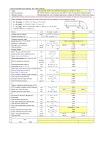A pump is a device that moves fluids (liquids or gases), or sometimes slurries, by mechanical action, typically converted from electrical energy into Hydraulic energy. Pumps can be classified into three major groups according to the method they use to move the fluid: direct lift, displacement, and gravity pumps.
Pumps operate by some mechanism (typically reciprocating or rotary), and consume energy to perform mechanical work moving the fluid. Pumps operate via many energy sources, including manual operation, electricity, engines, or wind power, and come in many sizes, from microscopic for use in medical applications, to large industrial pumps.
In these Article we will learn about some useful terms which are most used when dealing with the Liquid Pumps
- Cavitation :- Process in which small bubbles are formed and implode violently; occurs when NPSHa < NPSHr.
- Dead Head :- The ability of a pump to continue running without damage when discharge is closed off. Only recommended for centrifugal pumps.
- Density (specific weight of a fluid) :- Weight per unit volume, often expressed as grams per cubic centimeter.
- Flooded Suction :- Liquid flows to pump inlet from an elevated source by means of gravity. Recommended for centrifugal pump installations.
- Flow :- A measure of the liquid volume capacity of a pump. Usually given in liters per hour (L/hr).
- Fluids :- Include liquids, gases, and mixtures of liquids, solids, and gases.
- Head :- A measure of pressure, expressed in meters of head for centrifugal pumps. Indicates the height of a column of water being moved by the pump (without friction losses).
- Pressure :- The force exerted on the walls of a tank, pipe, etc., by a liquid. Normally measured in Barg.
- Prime :- Charge of liquid required to begin pumping action when liquid source is lower than pump. Held in pump by a foot valve on the intake line or by a valve or chamber within the pump.
- Seals :- Devices mounted in the pump housing and/or on the pump shaft that prevent leakage of liquid from the pump.
- Self-Priming :- Pumps that can draw liquid up from below pump inlet (suction lift), as opposed to pumps requiring flooded suction.
- Specific Gravity :- The ratio of the weight of a given volume of liquid to pure water. Pumping heavy liquids (specific gravity greater than 1.0) will require bigger motors.
- Static Discharge Head :- Maximum vertical distance (in meters) from pump to point of discharge with no flow.
- Strainer :- A device installed in the inlet of a pump to prevent foreign particles from damaging the internal parts.
- Sump :- A well or pit in which liquids collect below floor level; sometimes refers to an oil or water reservoir.
- Total Head :- Sum of discharge head, suction lift, and friction loss.
- Bypass Valve :- Internal to many pump heads that allow fluid to be recirculated if a given pressure limit is exceeded.
- Check Valve :- Allows liquid to flow in one direction only. Generally used in discharge line to prevent reverse flow.
- Foot Valve :- A type of check valve with a built-in strainer. Used at point of liquid intake to retain liquid in system, preventing loss of prime when liquid source is lower than pump.
- Relief Valve :- Used at the discharge of a positive displacement pump. An adjustable, spring-loaded valve opens when a preset pressure is reached. Used to prevent excessive pressure buildup that could damage the pump or motor.
- Viscosity :- The "thickness" of a liquid or its ability to flow. Most liquids decrease in viscosity and flow more easily as they get warmer.













0 Comments